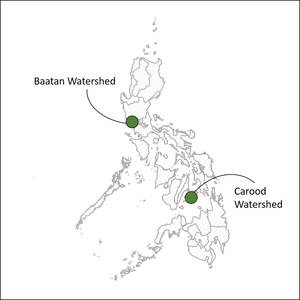Philippines
At the beginning of the last century, 70 percent of Philippines was forested, but this figure had declined rapidly to a low of about 18.3 percent in 1999. This is due both to anthropogenic and natural causes. Anthropogenic effects are primarily due to agriculture encroachment and logging activities by big companies. Natural causes, such as fires, pests and diseases, and natural calamities, especially typhoons, floods and landslides, also contribute to forest degradation. The occurrence of natural calamities has drastically increased over the last years because of climate change.
Deforestation and land degradation have had devastating consequences on biodiversity. With more than 20 000 endemic species, the Philippines is recognized as a megadiverse country: one of 17 nations that, together, hold two-thirds of earth’s biological diversity. The remaining biodiversity isolated on biodiverse islands and degraded lands cannot sustain long term food production for a growing population.
In more recent years, Philippines has made significant advances towards resolving historical trends causing net forest cover loss. This commitment is exemplified by embarking on a massive tree planting and reforestation program called the National Greening Program. In addition, the Integrated National Resources Management Program (INREMP) and the Forestland Management Program (FMP) are also involved in this initiative. From a position as one of the top ten deforestation countries contributing to 17-20 percent of global greenhouse gas (GHG) emissions from global forest loss in 2000 (FAO, 2006), the country has since recovered with a modest forest cover increase of 55 000 hectares (ha) per year (FAO, 2010); the 2010 Global Forest Assessment Country Report for Philippines reported an increase in forest cover from 6.57 million ha in 1990 to 7.66 million ha in 2010.
But these efforts need to be sustained in the long term as the re-greening program’s sustainability and ability to deliver multiple benefits has been questioned. The government and the local communities engaged in this effort need support.
In order to maintain this effort and the forest contribution to Philippines’ nationally determined contributions (NDCs) to the Paris Agreement, the Forest Landscape Restoration Mechanism (FLRM) has been supporting Philippines since 2016. In addition, it has since developed “The Paris Agreement in Action” project supported by the International Climate Initiative (IKI) of the German Ministry of the Environment (BMU) with Philippines being among the six focus countries – Philippines, Fiji, Morocco, Lebanon, Niger and Ethiopia.

IMPACTS
Philippines are very committed to promoting forest and landscape restoration (FLR). The project will support this effort and focus on three main pillars:
- An enabling environment is created for the implementation of national FLR programs and scaling up through inter sectoral coordination and relevant policy alignment.
- Restoration approaches are implemented in the selected sites with a high potential for FLR providing both carbon and non-carbon benefits through participatory and gender-responsive planning, community driven FLR investments and sustainable economic alternatives provided at landscape level.
- Monitoring capacity is enhanced and both socio-economic and environmental benefits are monitored with a minimum set of indicators well adapted to both national and regional contexts.
For more information of FLRM activities, click here:
- Status of the four main regional initiatives on FLR: a COFO side event organized by the FLRM
- Good governance propels FLR in Carood Watershed in Bohol, Philippines
- FLR in Selected Southeast Asian Countries
- Promoting the role of natural regeneration in large-scale FLR: challenges and opportunities, and the Regional Strategy and Action Plan for FLR in Asia-Pacific
- The strategy and action plan for FLR in the Asia-Pacific Region
- FLR: a key issue for the Asia-Pacific region

